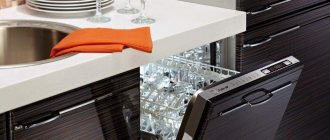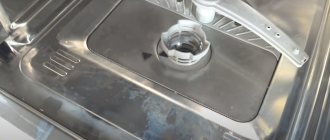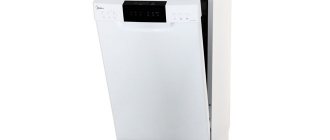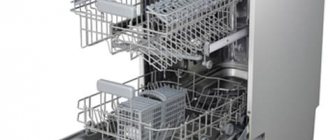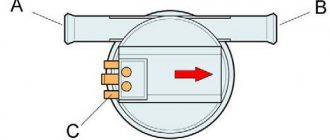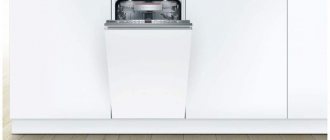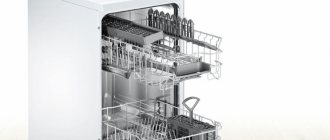- How to connect a drain hose to a sewer
Finally, you have fulfilled your dream - you have purchased a home assistant, a reliable dishwasher (hereinafter also referred to as PMM, dishwasher) from a German manufacturer. All that remains is to find out how to install a Bosch dishwasher with your own hands.
If you have the tools and appropriate skills, you can connect this equipment to the electrical network, water supply and sewerage yourself.
Every man can connect a dishwasher to communications and configure it
If you don’t want to understand the nuances of connecting equipment, call the company that sold the PMM and call a specialist. He will quickly install the unit, but you will have to pay for it.
Where to place the dishwasher
The place of any dishwasher in the kitchen, regardless of its type. Before you bought your favorite PMM model, you probably thought about options for its location. If your kitchen furniture has a niche specially designed for such a unit, or you are planning to purchase such a set, the ideal option would be a dishwasher that can be built in there.
Installing a built-in full-size dishwasher
Depending on the width of the niche, you will have to buy a narrow (45 cm wide) or full-size PMM (60 cm wide). The disadvantage of narrow dishwashers is that not all large-sized dishes (pots, baking sheets) can be washed in them .
Narrow built-in dishwasher in a small kitchen
If there is no special niche, you can find a place for a floor-standing PMM, standing separately. In the case where the room is small and there is no free space at all, you can buy a small tabletop dishwasher.
A small tabletop dishwasher will take up part of the countertop
The dishwasher should be located next to the sink - this will make it much easier to connect it to the water supply and sewerage system . You don’t have to purchase long hoses for filling and draining water; the ones included in the kit will be enough. In addition, in the event of a water hammer in the water supply, the likelihood of damage to a short inlet hose is much lower.
Installation of a built-in Bosch dishwasher will only be possible in a niche of a certain size (see drawing below).
The ratio of the dimensions of the niche and the body of a full-size built-in dishwasher
Choosing a location for the dishwasher
When manufacturing modern kitchen sets, the possibility of installing a built-in dishwasher must be taken into account. Therefore, the set has a special recess for installing household appliances and the fastening necessary to fix the machine. Usually, the accompanying instructions for the kitchen set indicate the type of fastening and which dishwashers it is suitable for. Using standard mounting sizes makes the installation process easier. If the fasteners do not match, they can be rearranged without much difficulty. The main thing is that before purchasing, carefully measure the niche allocated for installing the machine and then, when purchasing equipment, be guided by these dimensions, taking into account that the purchased dishwasher should easily fit into this niche.
Choosing a location for the dishwasher
Attention! Near the place where the dishwasher is installed there should be a European socket with high-quality grounding. Using regular outlets to connect a dishwasher is unsafe.
Preparatory stage
After the dishwasher is brought from the store, you need to follow a certain sequence of actions:
- check the integrity of the case and the presence of a complete set of PMM according to the attached instructions;
- install the unit in a pre-prepared place in the kitchen - in a furniture niche, on the floor or on a table;
- lead the drain hose into the sink sink or connect it through an adapter to a siphon that leads to the sewer;
- connect the water supply hose to the water supply using a tee, preferably with a safety valve, in order to shut off the water supply in case of an emergency;
- Run a separate power cable from the distribution panel and install an outlet intended only for the dishwasher (if you don’t already have one).
Pay special attention to ensure that the walls of the PMM case are not damaged or crushed during transportation. If you find such a defect, immediately file a claim with the seller and demand an exchange of damaged household appliances.
Built-in dishwasher before installation in the niche between the sink and washing machine
It is not recommended to install the PMM near heating appliances, as well as near refrigerators. During operation, the walls of the housings of such devices become very hot and affect the PMM body, overheating its internal parts and drying out the rubber seals.
Before you start connecting, we also recommend that you familiarize yourself with the operating principle of the equipment. This is discussed in detail in this article.
What tools and materials will be needed
To install a Bosch dishwasher yourself, prepare a set of tools, accessories and materials that you will definitely need during work.
You must have with you:
- a set of screwdrivers with Phillips and flat tips;
- pliers and duckbills;
- medium-sized adjustable wrench;
- waterproofing tape;
- coarse flow mesh filter;
- 3/4" threaded tee (26.44 mm OD) made of bronze or plastic;
- a safety valve, which must be installed separately in front of the inlet hose, or you can purchase a shut-off valve as part of a tee;
- siphon with outlet fitting (if there is no such siphon under the sink);
- hoses for filling and draining water of the required length (if those included in the kit are too short).
Many thrifty owners always have a set of necessary tools at hand.
Even if the dishwasher has an inlet mesh filter, installing an additional flow-through filter will not hurt, based on the quality of the water in our water supplies . To purchase the necessary materials, use the services of plumbing stores.
Instructions for carrying out work
If you have at least some plumbing skills, connecting the PMM to communications will not be difficult. Below is a general diagram of the connections between the dishwasher and communication systems.
Connecting the dishwasher to sewerage, water supply and electricity
How to connect a drain hose to a sewer
You should begin work by installing a siphon with a drain fitting under the sink. If there is also a washing machine installed in the kitchen, you should purchase a siphon with two outlet fittings - these are also on sale.
Siphon with two drain hoses connected to fittings
To prevent liquid from flowing out of the siphon in the opposite direction, and to prevent an unpleasant odor from spreading from the sewer, the drain hose must be secured in such a way that it has an upward bend in front of the siphon. If it is not included in the siphon design or if the hose is connected through a splitter directly into the sewer (after the siphon), it must be directed so that a bend is obtained. To do this, you can use a special insert (see photo below).
Special insert that bends the drain hose
To seal the connection between the hose and the siphon, union nuts are used. If the hose is inserted directly into the sewer, use a special insert or seal the connection in any other way.
In this case, it is not recommended to use sealant, since after this it will no longer be possible to disassemble the structure - you will have to change the entire assembly. Finish the job by connecting the hose to the dishwasher outlet.
Connecting the inlet hose to the water supply
Before performing the second step, carefully read the manufacturer's instructions. The fact is that some PMM models provide connections to both cold and hot water. When washing dishes, the liquid is mixed to the desired temperature, so there is no need to heat it. In this case, you will have to use two tees and connect two hoses to the water supply. But most often you only need to connect cold water.
Even if a connection to cold and hot water is provided, experts recommend connecting only to the cold main due to the poor quality and low temperature of the liquid in the centralized hot water supply.
It is most convenient to install a tee with a shut-off valve at the junction of the pipe and the cold water hose leading to the sink
The inlet and outlet of the tee splitter should be 1/2 inch (20.1 mm outer diameter), the side branch should be 3/4 inch. The shut-off valve must be easily accessible in order to quickly turn off the water in an emergency.
In the case where a washing machine is already connected to the water supply under the sink, use a manifold with two outlets, each of which is equipped with its own ball shut-off valve (see photo).
Water supply manifold with two side outlets
How to connect a dishwasher to the mains
The power of the dishwasher is approximately 2.5–3 kW. Such equipment must be connected to a separate power line coming from the input distribution panel. At the input of the line, you need to place a circuit breaker, which should operate at a current of 16 A, and a residual current device (hereinafter also referred to as an RCD), also at 16 A and 10 mA of leakage current. It is better to choose a copper 3-core cable, with a cross-section of 2.5 mm2, with double insulation.
Connection diagram of the dishwasher to the electrical network
The socket must also withstand a current of 16 A. The cable can be laid by cutting through the walls from the panel to the socket in the kitchen. Or lay the cable in a small box, securing it to the wall surface with self-tapping screws. This wiring option looks good. Grooves will ruin the walls; they are convenient to do only during renovation.
Cable wiring in a box on the surface of the walls
As you can see, there is nothing particularly complicated about connecting a dishwasher to communications. When laying the electrical network, strictly follow safety regulations - turn off the power to the apartment to avoid electric shock.
Electrical connection
Connecting to the power supply is an important stage in the installation of a Bosch dishwasher, the solution of which should be considered even before installing the machine in the chosen location. Since the sockets in the kitchen are located above the work surface, you should make a wire tap by connecting an additional socket in a convenient place, at a height of up to 1/2 m from the floor. It is important to consider the following points:
- Do not use extension cords to connect the dishwasher.
- Do not connect a dishwasher and an electric stove to the same outlet.
- The outlet for the dishwasher must be splash-proof.
After installing the PMM, the legs are adjusted and the false panel is installed
